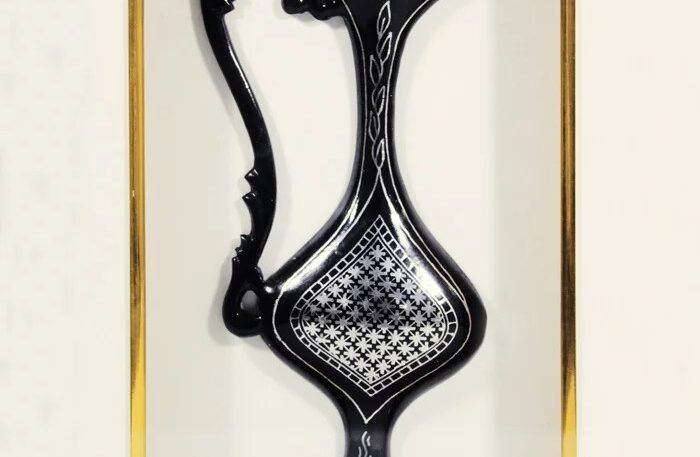Bidri Art History is a distinctive type of metalwork that distinguishes out due to its elaborate designs and rich cultural legacy. This art form, which originated in the Indian state of Karnataka, is well-known for its eye-catching black and silver patterns that decorate everything from jewelry and ornamental items to vases and dishes. In addition to its striking aesthetics, Bidri Art’s rich cultural heritage and long history are what really set it apart.
Introduction

Historical Background of Bidri Art History
Origins in Persia
The origins of bidri art History can be found in Persia, where metal inlay artists worked on comparable projects. During the 14th-century Bahmani Sultanate, Persian artists and artisans introduced this form of art to India.
Introduction to India
The Deccan region of India proved to be a rich field for the art form, especially in Bidar where it flourished under royal patronage. A distinctive style known as “Bidri” was created as a result of the blending of Persian skills with indigenous artistic abilities.
Evolution over Centuries
Bidri art History changed over the ages, absorbing new inspirations and molding to suit shifting fashions. The artists of Bidar persisted in their innovation, guaranteeing the continuation and expansion of this magnificent art form, even in the face of dwindling royal sponsorship.
The Cultural Significance of Bidri Art

Symbolism in Designs
Bidri art designs frequently have complex symbolic implications. Common patterns include florals, geometrics, and Islamic art-inspired themes, each having a special meaning.
Influence on Indian Culture
Indian culture has been greatly impacted by bidri art History, which has added to the rich tapestry of traditional crafts. Its dual role as a decorative and practical item in houses and palaces emphasizes its significance in everyday life and cultural customs.
Materials and Techniques Used in Bidri Art
Primary Materials
An alloy consisting primarily of zinc and copper serves as the foundation for Bidri Art. Silver is usually utilized for the inlay work, while brass and gold are also infrequently employed.
Traditional Techniques
The ancient methods of creating Bidri art entail molding the alloy into the proper forms, etching elaborate designs, and then inserting silver into the grooves. The alloy is finally oxidized to a jet black color, which creates a striking contrast to the glossy inlaid metal.
Modern Innovations
Modern developments include the use of new materials and designs to suit modern tastes, although the ancient procedures stay mostly unchanged. In the current art market, Bidri Art remains relevant due to its unique blend of heritage and modernity.
The Process of Creating Bidri Art
Designing the Base
Creating the base object is the first step in the procedure. The zinc and copper alloy is expertly shaped by artisans, guaranteeing a flawless surface for the fine work that comes next.
Inlaying the Metals
The most delicate step is to engrave the design onto the base and insert fine silver wires into the grooves. Due to the intricacy of the designs, accuracy and skill are required.
Oxidizing and Polishing
Oxidizing the alloy is the last phase, which gives it a deep black hue. There’s a dramatic difference since the silver doesn’t get damaged. To bring out the sheen and intricacy, the object is then polished.
Themes and Motifs in Bidri Art
Common Patterns
Arabesques, geometric patterns, and floral themes are common patterns in bidri art. These patterns, which show the historical and cultural influences on Bidri workmanship, are frequently influenced by Islamic art and the natural world.
Cultural and Religious Themes
Numerous pieces by Bidri incorporate spiritually significant symbols and motifs along with cultural and religious topics. These things are frequently used in homes as significant and ornamental accents.
Modern Adaptations
New themes and motifs have been added to bidri art in the modern era. Contemporary artists are expanding the appeal of this age-old craft by experimenting with abstract ideas and designs that speak to a worldwide audience.
Bidri Art in Contemporary Times
Current Practitioners
Even with the difficulties, there are still a lot of talented Bidri craftspeople working in this field today. They keep on passing on their knowledge to future generations, accepting new ideas but still maintaining the use of old techniques.
Popularity in Modern Art Circles
Due to the distinct aesthetic that modern artists and collectors value in Bidri Art History, it has become more and more well-known in the world of modern art. Bidri sculptures are frequently displayed at exhibitions and art fairs, highlighting the beauty and adaptability of this age-old art form.
Market Demand and Commercial Value
Bidri Art’s market value has increased due to the growing interest from global art collectors and fans. This demand promotes the continuation of the craft and aids in the maintenance of the artists.
Challenges Faced by Bidri Artisans
Economic Difficulties
Economic uncertainty is a key difficulty encountered by artisans from Bidri art history. For artisans, maintaining their livelihoods can be challenging because to the unpredictability of demand and the exorbitant cost of materials.
Preservation of Techniques
A further obstacle is keeping old methods alive. In the long run, these talents run the risk of being lost since fewer young people are pursuing the art.
Competition from Modern Art Forms
Modern art and mass-produced goods, which are frequently more affordable and accessible, are other competitors for bidri art. Traditional craftspeople may find it challenging to compete in the market as a result of this competition.
Government and Private Initiatives for Revival
Government Schemes
Govt has been taken several initiative to light up Bidar art history specially focusing the improvement of arctician life . many reward program , Digital content contest on Bidri art History, Insurance claim scheme, recently launched PM vishwakarma scheme also supporting lot to tp flourish Bidar art history.
NGO Efforts
In addition, non-governmental organizations (NGOs) are essential to the revival of Bidri Art. They give artists platforms, tools, and instruction so they may display and market their creations.
Role of Art Collectors and Enthusiasts
Purchasing Bidri items and supporting the art form is an important contribution made by art aficionados and collectors. Their assistance keeps the craft alive and provides for the craftspeople. to purchase online click here
The Future of Bidri Art History
Potential for Global Reach
Bidri Art can potentially be seen by people all around the world. This age-old craft can find new markets and enthusiasts globally with greater awareness and appreciation.
Innovations and Adaptations
Bidri Art may remain current through design and technique innovations and adaptations. Craftspeople can appeal to modern preferences while maintaining their history by fusing traditional techniques with contemporary styling.
Educational Programs and Workshops on Bidar art history
Workshops and educational initiatives are crucial to the survival of Bidri Art History. These programs can guarantee that information and skills are passed down to future generations, educate the public, and assist in the training of new artisans.
Famous Bidri Artisans and Their Contributions
Notable Artisans Through History
Numerous eminent craftsmen have made significant contributions to the creation and upkeep of Bidri Art throughout history. Their exquisite craftsmanship and artistic brilliance are widely praised in their works.
Contemporary Masters
Today, contemporary masters continue to innovate and inspire. Their contributions ensure that Bidri Art remains a vibrant and evolving craft.
Bidri Art in Museums and Exhibitions
Major Exhibitions Worldwide
Major international shows that have highlighted Bidri Art have raised awareness of this distinctive skill. These shows give craftspeople a stage on which to present their creations and connect with a wider audience.
Significant Museum Collections
Significant collections of Bidri Art can be found in numerous museums worldwide. For the sake of future generations’ study and appreciation, these collections aid in maintaining the history and legacy of this craft.
How to Identify Authentic Bidri Art
Key Characteristics
The distinctive blackened surface and elaborate silver inlay work are telltale signs of authentic Bidri art. Other important markers of authenticity include the level of craftsmanship and attention to detail.
Common Imitations and How to Spot Them
Cheaper materials and less accurate methods are frequently used in common imitations. Look for irregularities in the piece’s general finish, the inlay work’s quality, and the design to identify them.
Collecting and Caring for Bidri Art
Tips for Collectors
Collecting enthusiasts should make sure they purchase from reliable vendors and confirm the authenticity of the items. Gaining knowledge about the background and importance of Bidri Art can also improve the experience of acquiring it.
Maintenance and Preservation
In order to maintain its beauty, bidri art needs to be well maintained. To maintain the silver inlay’s luster, keep it away from dampness and harsh chemicals and give it regular polishing.
Conclusion
India’s rich cultural legacy and artistic brilliance are demonstrated by Bidri art. It is a priceless and valued art form because of its elaborate designs and historical relevance. It is imperative that we assist the artists, uphold the ancient methods, and spread awareness of Bidri Art around the world as we look to the future. By doing this, we can make sure that this exquisite craft survives for many more years. Bidri art and craft is reaching through cutting-edge ecommerce services.
FAQs
1. What is Bidri Art? Bidri Art is a traditional form of metalwork originating from Bidar, India, known for its intricate silver inlay on a blackened alloy base.
2. How is Bidri Art made? The process involves casting a zinc and copper alloy base, engraving designs, inlaying silver, and oxidizing the piece to achieve a black finish with shining silver patterns.
3. What materials are used in Bidri Art? The primary materials are an alloy of zinc and copper for the base and silver for the inlay work. Sometimes, gold and brass are also used.
4. Why is Bidri Art significant? Bidri Art is significant due to its historical roots, cultural symbolism, and the unique craftsmanship that has been passed down through generations.
5. How can I identify authentic Bidri Art? Authentic Bidri Art can be identified by its detailed silver inlay, the quality of craftsmanship, and the characteristic black finish. It’s also advisable to buy from reputable sources.





